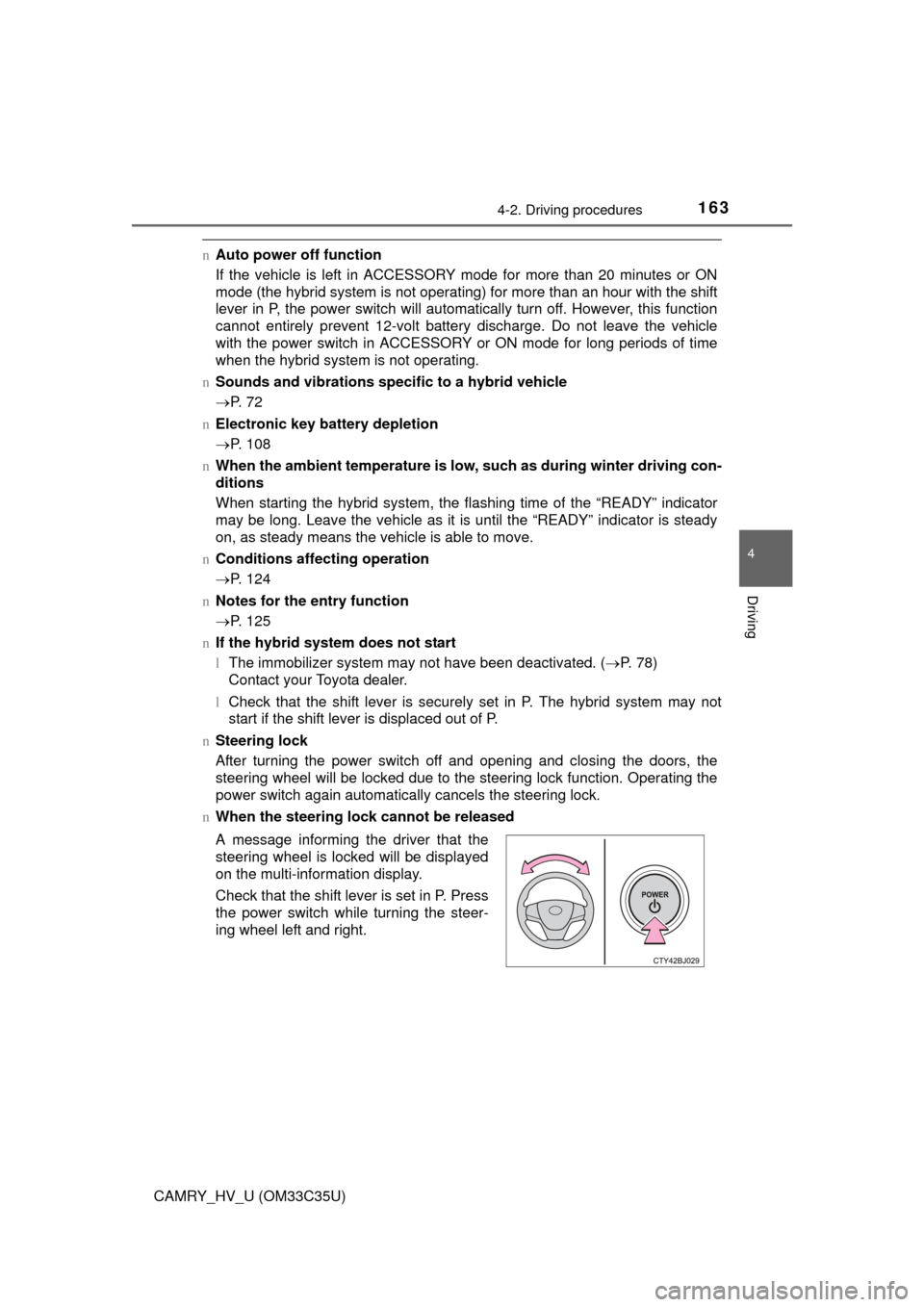Page 159 of 572
1594-1. Before driving
4
Driving
CAMRY_HV_U (OM33C35U)
Trailer towing
Toyota does not recommend towing a trailer with your vehicle.
Toyota also does not recommend th e installation of a tow hitch
or the use of a tow hitch carrier for a wheelchair, scooter, bicy-
cle, etc. Your vehicle is not designed for trailer towing or for the
use of tow hitch mounted carriers.
Page 160 of 572
1604-1. Before driving
CAMRY_HV_U (OM33C35U)
Dinghy towing
Your vehicle is not designed to be dinghy towed (with 4 wheels
on the ground) behind a motor home.
NOTICE
nTo avoid serious damage to your vehicle
Do not tow your vehicle with four wheels on the ground.
Page 163 of 572

1634-2. Driving procedures
4
Driving
CAMRY_HV_U (OM33C35U)
nAuto power off function
If the vehicle is left in ACCESSORY mode for more than 20 minutes or ON
mode (the hybrid system is not operating) for more than an hour with the shift
lever in P, the power switch will automatically turn off. However, this function
cannot entirely prevent 12-volt battery discharge. Do not leave the vehicle
with the power switch in ACCESSORY or ON mode for long periods of time
when the hybrid system is not operating.
n Sounds and vibrations specific to a hybrid vehicle
P. 7 2
n Electronic key battery depletion
P. 108
n When the ambient temperature is low, such as during winter driving con-
ditions
When starting the hybrid system, the flashing time of the “READY” indicator
may be long. Leave the vehicle as it is until the “READY” indicator is steady
on, as steady means the vehicle is able to move.
n Conditions affecting operation
P. 124
n Notes for the entry function
P. 125
n If the hybrid system does not start
lThe immobilizer system may not have been deactivated. ( P. 78)
Contact your Toyota dealer.
l Check that the shift lever is securely set in P. The hybrid system may not
start if the shift lever is displaced out of P.
n Steering lock
After turning the power switch off and opening and closing the doors, the
steering wheel will be locked due to the steering lock function. Operating the
power switch again automatically cancels the steering lock.
n When the steering lock cannot be released
A message informing the driver that the
steering wheel is locked will be displayed
on the multi-information display.
Check that the shift lever is set in P. Press
the power switch while turning the steer-
ing wheel left and right.
Page 177 of 572

1774-3. Operating the lights and wipers
4
Driving
CAMRY_HV_U (OM33C35U)
nThe Automatic High Beam can be operated when
The power switch is in ON mode.
n Camera sensor detection information
lHigh beam may not be automatically turned off in the following situations:
• When oncoming vehicles suddenly appear from a curve
• When the vehicle is cut in front of by another
• When oncoming or preceding vehicles are hidden from sight due to
repeated curves, road dividers or roadside trees
• When oncoming vehicles appear from the faraway lane on wide road
• When oncoming or preceding vehicles have no lights
l High beam may be turned off if an oncoming vehicle that is using fog lights
without using the headlights is detected.
l House lights, street lights, red traffic signals, and illuminated billboards or
signs may cause the high beam to turn off.
l The following factors may affect the amount of time taken to turn high beam
on or off:
• The brightness of headlights, fog lights, and tail lights of oncoming and
preceding vehicles
• The movement and direction of oncoming and preceding vehicles
• When a oncoming or preceding vehicle only has operational lights on one side
• When a oncoming or preceding vehicle is a two-wheeled vehicle
• The condition of the road (gradient, curve, condition of the road surface
etc.)
• The number of passengers and amount of luggage
l High beam may be turned on or off when unexpected by the driver.
Page 200 of 572
2004-5. Using the driving support systems
CAMRY_HV_U (OM33C35U)
WARNING
lMotorcycles traveling in the same lane
l When water or snow thrown up by the surrounding vehicles hinders the
detecting of the sensor
n Conditions under which the vehicle -to-vehicle distance control mode
may not function correctly
Operate the brake pedal (or accelerator pedal operation depending on the
situation) as necessary in the follow ing conditions as the radar sensor may
not be able to correctly detect vehicles ahead, which may lead to an acci-
dent resulting in death or serious injury.
l When the vehicle ahead of you decelerates suddenly
lWhen your vehicle is pointing upwards
(caused by a heavy load in the trunk,
etc.)
lWhen the road curves or when the
lanes are narrow
l When steering wheel operation or your
position in the lane is unstable
Accelerate Accelerate Decelerate
Page 206 of 572

2064-5. Using the driving support systems
CAMRY_HV_U (OM33C35U)
WARNING
nBefore using the LDA system
Do not rely solely on the LDA system. The LDA system does not drive the
vehicle automatically, nor does it reduce the amount of care you need to
take. As such, the driver must always assume full responsibility for under-
standing his/her surroundings, for operating the steering wheel to correct
the driving line, and for driving safely.
Inappropriate or negligent driving could lead to an accident.
n To avoid operating the LDA by mistake
Switch the LDA system off using the LDA switch when not in use.
n Situations unsuitable for LDA system
Do not use the LDA system in any of the following situations.
Otherwise, the system may not function correctly and could result in an
accident.
lWhen driving with tire chains, a spare tire, or similar equipment
l When there are objects or structures along the roadside that might be mis-
interpreted as lane markers (such as guardrails, a curb, reflector posts,
etc.)
l When driving on snowy roads
l When pavement lane markers are difficult to see due to rain, snow, fog,
sand, dirt, etc.
l When there are visible lines on the pavement from road repairs, or if the
remains of old lane markers are still visible on the road
l When driving on a road with lane closures due to maintenance, or when
driving in a temporary lane
Page 216 of 572

2164-5. Using the driving support systems
CAMRY_HV_U (OM33C35U)
WARNING
nWhen using the rear view monitor system
The rear view monitor system is a supplemental device intended to assist
the driver when backing up. When backing up, be sure to check visually
behind and all around the vehicle before proceeding.
Observe the following precautions to avoid an accident that could result in
death or serious injuries.
l Never depend on the rear view monitor system entirely when backing up.
The image and the position of the guide lines displayed on the screen may
differ from the actual state.
Use caution, just as you would when backing up any vehicle.
l Be sure to back up slowly, depressing the brake pedal to control vehicle
speed.
l The instructions given are only guidelines.
When and how much to turn the steering wheel will vary according to traf-
fic conditions, road surface conditions, vehicle condition, etc. when park-
ing. It is necessary to be fully aware of this before using the rear view
monitor system.
l When parking, be sure to check that the parking space will accommodate
your vehicle before maneuvering into it.
l Do not use the rear view monitor system in the following cases:
• On icy or slick road surfaces, or in snow
• When using tire chains or the compact spare tire
• When the trunk lid is not closed completely
• On roads that are not flat or straight, such as curves or slopes.
l In low temperatures, the screen may darken or the image may become
faint. The image could distort when the vehicle is moving, or you may
become unable to see the image on the screen. Be sure to check direct
visually and with the mirrors all around the vehicle before proceeding.
l If the tire sizes are changed, the position of the fixed guide lines displayed
on the screen may change.
l The camera uses a special lens. The distances between objects and
pedestrians that appear in the image displayed on the screen will differ
from the actual distances. ( P. 211)
Page 218 of 572

2184-5. Using the driving support systems
CAMRY_HV_U (OM33C35U)
uECB (Electronically Controlled Brake System)
The electronically controlled system generates braking force corre-
sponding to the brake operation
uABS (Anti-lock Brake System)
Helps to prevent wheel lock when the brakes are applied suddenly,
or if the brakes are applied while driving on a slippery road surface
uBrake assist
Generates an increased level of braking force after the brake pedal
is depressed when the system detects a panic stop situation
uVSC (Vehicle Stability Control)
Helps the driver to control skidding when swerving suddenly or
turning on slippery road surfaces
uEnhanced VSC (Enhanced Ve hicle Stability Control)
Provides cooperative control of the ABS, TRAC, VSC and EPS.
Helps to maintain directional st ability when swerving on slippery
road surfaces by controllin g steering performance.
uTRAC (Traction Control)
Helps to maintain drive power and prevent the drive wheels from
spinning when starting the vehicle or accelerating on slippery roads
uHill-start assist control
Prevents the vehicle from rolling backward when starting on an
incline or slippery slope
Driving assist systems
To help enhance driving safety and performance, the following
systems operate automatically in response to various driving
situations. Be aware, however, that these systems are supple-
mentary and should not be relied upon too heavily when operat-
ing the vehicle.